The Intel Comet Lake Core i9-10900K, i7-10700K, i5-10600K CPU Review: Skylake We Go Again
by Dr. Ian Cutress on May 20, 2020 9:00 AM EST- Posted in
- CPUs
- Intel
- Skylake
- 14nm
- Z490
- 10th Gen Core
- Comet Lake
Our Office and Science Test section focuses significantly on real-world testing, user experience, with a slight nod to throughput. In this section we cover application loading time, image processing, simple scientific physics, artificial intelligence, and AVX accelerated code.
All of our benchmark results can also be found in our benchmark engine, Bench.
Office Tests
Application Load: GIMP 2.10.4
One of the most important aspects about user experience and workflow is how fast does a system respond. A good test of this is to see how long it takes for an application to load. Most applications these days, when on an SSD, load fairly instantly, however some office tools require asset pre-loading before being available. Most operating systems employ caching as well, so when certain software is loaded repeatedly (web browser, office tools), then can be initialized much quicker.
In our last suite, we tested how long it took to load a large PDF in Adobe Acrobat. Unfortunately this test was a nightmare to program for, and didn’t transfer over to Win10 RS3 easily. In the meantime we discovered an application that can automate this test, and we put it up against GIMP, a popular free open-source online photo editing tool, and the major alternative to Adobe Photoshop. We set it to load a large 50MB design template, and perform the load 10 times with 10 seconds in-between each. Due to caching, the first 3-5 results are often slower than the rest, and time to cache can be inconsistent, we take the average of the last five results to show CPU processing on cached loading.
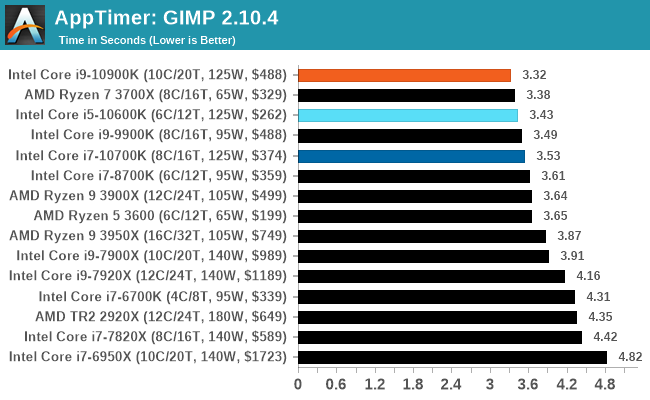
GIMP likes fast single core performance, and so the Core i9 wins here.
Agisoft Photoscan 1.3.3: 2D Image to 3D Model Conversion
One of the ISVs that we have worked with for a number of years is Agisoft, who develop software called PhotoScan that transforms a number of 2D images into a 3D model. This is an important tool in model development and archiving, and relies on a number of single threaded and multi-threaded algorithms to go from one side of the computation to the other.
In our test, we take v1.3.3 of the software with a good sized data set of 84 x 18 megapixel photos and push it through a reasonably fast variant of the algorithms, but is still more stringent than our 2017 test. We report the total time to complete the process.
Agisoft’s Photoscan website can be found here: http://www.agisoft.com/
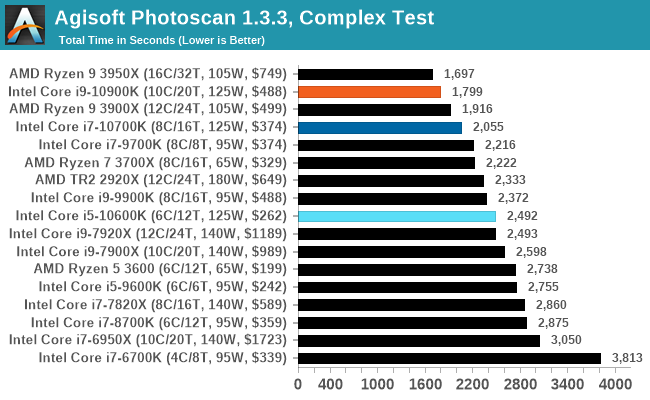
Agisoft is a mix of variable threaded workloads, so a good balanced system works best. Intel's $500 option is faster than AMD's $500 option here, with two fewer cores.
AI Benchmark
One of the longest time requests we’ve had for our benchmark suite is AI-related benchmark, and the folks over at ETH have moved their popular AI Benchmark from mobile over PC. Using Intel’s MKL and Tensorflow 2.1.0, we use version 0.1.2 of the benchmark which tests both training and inference over a variety of different models. You can read the full scope of the benchmark here.
This is one of our new tests in the database, and we are still gaining data for it.
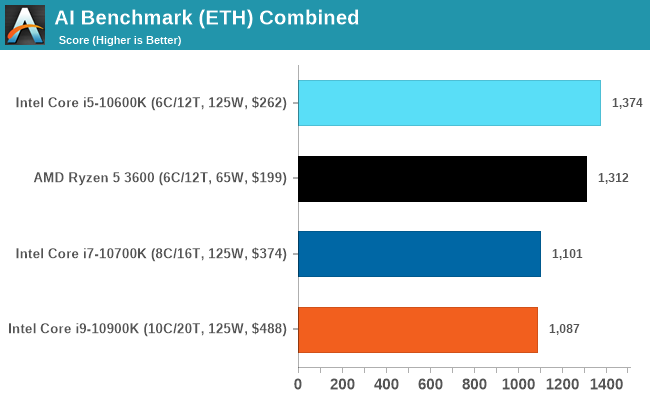
AIBench is a new test here, covering both training and inference. In the breakdown of results, we noticed that the faster processors were actually slower, scoring a lower result. We believe this is down to the lower bandwidth/core afforded by the 10c design against the 6c design.
Accelerated Science Tests
3D Particle Movement v2.1: Brownian Motion
Our 3DPM test is a custom built benchmark designed to simulate six different particle movement algorithms of points in a 3D space. The algorithms were developed as part of my PhD., and while ultimately perform best on a GPU, provide a good idea on how instruction streams are interpreted by different microarchitectures.
A key part of the algorithms is the random number generation – we use relatively fast generation which ends up implementing dependency chains in the code. The upgrade over the naïve first version of this code solved for false sharing in the caches, a major bottleneck. We are also looking at AVX2 and AVX512 versions of this benchmark for future reviews.
For this test, we run a stock particle set over the six algorithms for 20 seconds apiece, with 10 second pauses, and report the total rate of particle movement, in millions of operations (movements) per second. We have a non-AVX version and an AVX version, with the latter implementing AVX512 and AVX2 where possible.
3DPM v2.1 can be downloaded from our server: 3DPMv2.1.rar (13.0 MB)


No real surprises in our 3DPM tests.
y-Cruncher v0.7.6: Microarchitecture Optimized Compute
I’ve known about y-Cruncher for a while, as a tool to help compute various mathematical constants, but it wasn’t until I began talking with its developer, Alex Yee, a researcher from NWU and now software optimization developer, that I realized that he has optimized the software like crazy to get the best performance. Naturally, any simulation that can take 20+ days can benefit from a 1% performance increase! Alex started y-cruncher as a high-school project, but it is now at a state where Alex is keeping it up to date to take advantage of the latest instruction sets before they are even made available in hardware.
For our test we run y-cruncher v0.7.6 through all the different optimized variants of the binary, single threaded and multi-threaded, including the AVX-512 optimized binaries. The test is to calculate 250m digits of Pi, and we use the single threaded and multi-threaded versions of this test.
Users can download y-cruncher from Alex’s website: http://www.numberworld.org/y-cruncher/
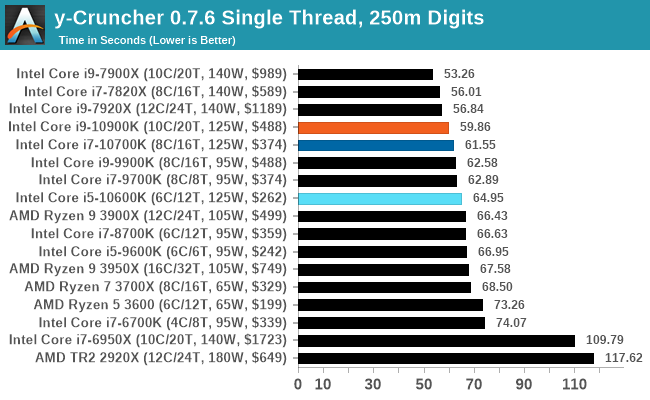
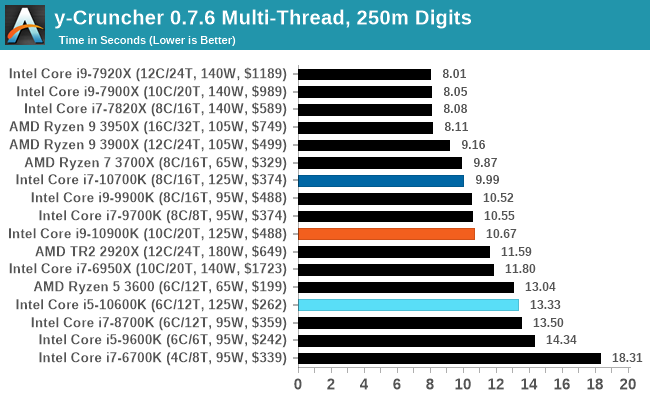
y-Cruncher is another one where the Core i9 performs worse than the Core i7 in the multithreaded test, despite being better on the single threaded test. We again put this down to memory bandwidth. We need to update this test to the latest version of y-Cruncher, which has additional optimizations for Zen 2 processors, but also to increase the digit count in our MT test.











220 Comments
View All Comments
Ryan Smith - Tuesday, May 26, 2020 - link
To be sure, it's GTX 1080. IGP is the name of the setting.F123Nova - Saturday, May 23, 2020 - link
I am trying my best to be nice, but this article has the most dubious set of benchmarks I have seen, and the omission in the charts of Intel competition in certain charts where the competition is better makes me wonder why this article smells of a cash handout. Cant say for sure if this is another "Just buy it" piece, but it sure smells foul. I expected more from Anandtech...Ryan Smith - Tuesday, May 26, 2020 - link
Hi Nova,As has been the case for the past 23 years, we always strive to have accurate reporting, to the best of our abilities.
Given that we're in the process of rolling out some new benchmarks (such as the Crysis software render), we haven't yet had a chance to backfill in results for a number of processors. Unfortunately that's going to take some time. But in the meantime, was there any specific benchmark(s) you were concerned about? That might at least help us better prioritize what to backfill first.
And to be sure, there's no cash handout. That's not how we operate. (Selling out for anything less than an incredibly comfortable retirement isn't very helpful for our future employment prospects)
tvdang7 - Wednesday, May 27, 2020 - link
why couldnt AT use a 3800x instead of a 3700x.pcgpus - Friday, July 10, 2020 - link
Nice review. 10600K might be a new king in games (for fair price).If you want to compare this article with other services You have to go on this link:
https://warmbit.blogspot.com/2020/06/intel-core-10...
There are results from 9 services from 32 games!
After page load please pick up your language from google translate (right side of page).
pcgpus - Friday, July 10, 2020 - link
Nice review. 10900K is the new king in games!If you want to compare this article with other services You have to go on this link:
https://warmbit.blogspot.com/2020/06/intel-core-i9...
There are results from 9 services from 35 games!
After page load please pick up your language from google translate (right side of page).
Meteor2 - Wednesday, July 15, 2020 - link
A new microarchitecture doesn’t require a new process. When PAO immediately went south, I don’t understand why Intel didn’t just implement a new microarchitecture on 14 nm. Surely Ice Lake hasn’t taken four years to develop?Meteor2 - Wednesday, July 15, 2020 - link
*Sunny Cove. God Intel’s code-names are dumbmiss5tability - Saturday, August 8, 2020 - link
i just discovered this INTEL SCAM, now i dont freaking understand how those 10 gen cpu works i wanna buy i3 10300 and what im reading this is not 65W chip? what is real f@#%$@ power draw for those cpusdamian101 - Monday, August 10, 2020 - link
As far as I know Intel never used a single bidirectional ring bus on CPUs with more than 10 cores.On Intel Ivy Bridge CPUs with 12 and more (15) cores, Intel used three unidirectional ring buses. There were also no Sandy Bridge CPUs with more than 10 cores, and Intel used two bidirectional ring buses connected with buffered switches for their high core count Haswell CPUs.